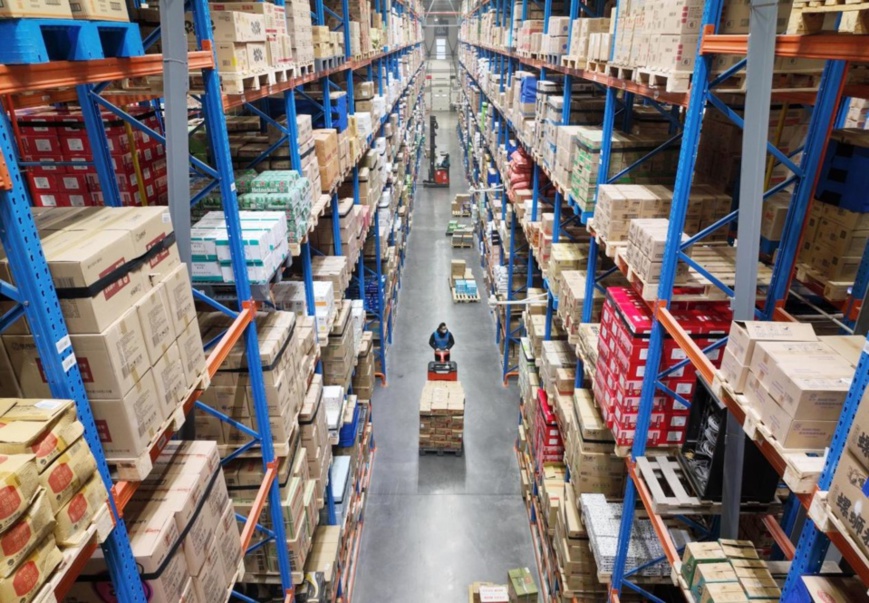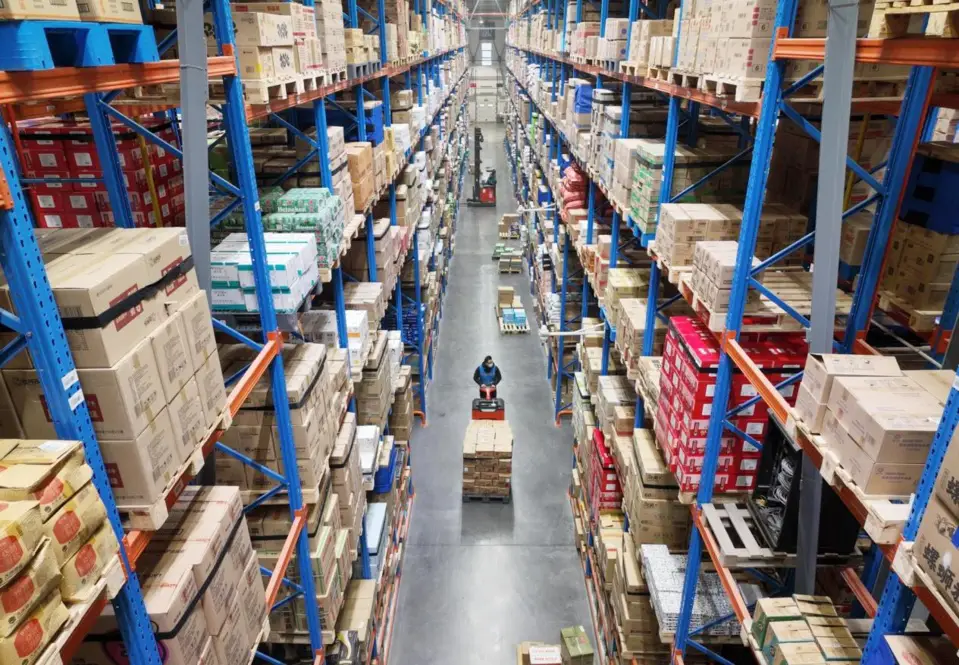By Song Yiran, People’s Daily

Logistics workers are busy transferring products in Fancheng district, Xiangyang city, central China’s Hubei province, Jan. 17, 2022. (Photo by Xie Yong/People’s Daily Online)
To break local protection and facilitate the smooth flow of economic circulation, China on April 10th issued guidelines on building a unified national market at a faster pace.
The guidelines will help promote the smooth flow of goods, factors, and resources on a wider scale for the purpose of building a unified national market that is highly efficient, rules-based, fair and open.
China is the second largest consumer market in the world. However, the large consumer market isn’t equal to a truly large-scale market. The new regulation eyes a comprehensive push for the country’s market to shift from being big toward becoming powerful.
The lack of unified system and rules, impeded flow of factors and resources, market segmentation, as well as other prominent problems, have hindered the realization of functions of its market.
In an effort to address these problems, the guidelines clarified the major tasks for building a unified national market, including promoting efficient circulation and expansion of the domestic market, fostering a stable, fair, transparent and predictable business environment, further reducing market transaction costs, boosting scientific and technological innovation and industrial upgrading, and cultivating a key competitive edge in international competition and cooperation.
A unified national market is by no means a large market of egalitarianism. Each region in China has its own resource endowments and different comparative advantages in goods and factors.
By building a unified national market, China will remove obstacles that hinder the flow of factors, give full play to the comparative advantages of various regions, and ensure efficient performance of capital, resources, commodities, services, data, and other market factors.
Besides, the country will be able to achieve optimal resource allocation, maximize the benefits of the entire economy and society while helping each region make the most of the market.
The document clearly charted the basic routes for advancing the construction of a unified national market.
China will further unify the basic systems and rules, including those for property rights protection, market access, fair competition and social credit, said the guideline. It will strictly implement the “one negative list for the whole country” management model, treat all market entities equally, and form a full-coverage credit information network, according to the document.
To build a unified national market, the country needs to stimulate the flow of factors and resources so as to vitalize the economy.
Based on previous pilot reforms, the guidelines stressed building unified markets in factors and resources including land, labor, capital, technology, data, energy, and ecological environment.
The faster flow of factors and resources is expected to generate a multiplier effect and give new impetus to economic development.
In a bid to advance the construction of a unified national market, China should provide higher-quality products and services by constantly improving relevant standards.
Laying high emphasis on the role of goods quality and standard systems in market construction, the guidelines proposed systematic institutional designs in this respect. The country will carry out a campaign for upgrading goods quality management system, which is expected to effectively enhance quality management throughout the whole industrial chain.
The document said that the country will align the quality standards of major consumer goods in key areas with international standards, and ensure that products sold domestically are produced on the same production lines, meet the same standards, and are of the same quality as exported ones, thus effectively facilitating the connection between domestic and international circulation.
As regards the construction of the standard and measurement system, the guidelines proposed integrating and simplifying national and industry standards, and pointed the way forward for the construction of standards in emerging fields.
China needs to supervise the market in a more scientific way in order to ensure the latter working in a stable and predictable way. The guidelines stressed the necessity to standardize the market supervision, regulate law enforcement behavior, unify law enforcement standards and procedures, and reduce discretionary power, which is expected to effectively improve the efficiency of supervision and promote fair and just law enforcement.
In order to guarantee sound development of new business forms and models, the country needs to lay emphasis on both regulating supervision and promoting development and close the loopholes in relevant laws and standards in time while promoting online and offline integrated supervision, said the document.
By accelerating the construction of a unified national market, creating more market demands, releasing greater consumption potential, expanding circulation space and forming a more transparent business environment, the country will stabilize market expectations, promote sustainable and healthy economic development, and make its economy more vibrant and dynamic.
The guidelines will help promote the smooth flow of goods, factors, and resources on a wider scale for the purpose of building a unified national market that is highly efficient, rules-based, fair and open.
China is the second largest consumer market in the world. However, the large consumer market isn’t equal to a truly large-scale market. The new regulation eyes a comprehensive push for the country’s market to shift from being big toward becoming powerful.
The lack of unified system and rules, impeded flow of factors and resources, market segmentation, as well as other prominent problems, have hindered the realization of functions of its market.
In an effort to address these problems, the guidelines clarified the major tasks for building a unified national market, including promoting efficient circulation and expansion of the domestic market, fostering a stable, fair, transparent and predictable business environment, further reducing market transaction costs, boosting scientific and technological innovation and industrial upgrading, and cultivating a key competitive edge in international competition and cooperation.
A unified national market is by no means a large market of egalitarianism. Each region in China has its own resource endowments and different comparative advantages in goods and factors.
By building a unified national market, China will remove obstacles that hinder the flow of factors, give full play to the comparative advantages of various regions, and ensure efficient performance of capital, resources, commodities, services, data, and other market factors.
Besides, the country will be able to achieve optimal resource allocation, maximize the benefits of the entire economy and society while helping each region make the most of the market.
The document clearly charted the basic routes for advancing the construction of a unified national market.
China will further unify the basic systems and rules, including those for property rights protection, market access, fair competition and social credit, said the guideline. It will strictly implement the “one negative list for the whole country” management model, treat all market entities equally, and form a full-coverage credit information network, according to the document.
To build a unified national market, the country needs to stimulate the flow of factors and resources so as to vitalize the economy.
Based on previous pilot reforms, the guidelines stressed building unified markets in factors and resources including land, labor, capital, technology, data, energy, and ecological environment.
The faster flow of factors and resources is expected to generate a multiplier effect and give new impetus to economic development.
In a bid to advance the construction of a unified national market, China should provide higher-quality products and services by constantly improving relevant standards.
Laying high emphasis on the role of goods quality and standard systems in market construction, the guidelines proposed systematic institutional designs in this respect. The country will carry out a campaign for upgrading goods quality management system, which is expected to effectively enhance quality management throughout the whole industrial chain.
The document said that the country will align the quality standards of major consumer goods in key areas with international standards, and ensure that products sold domestically are produced on the same production lines, meet the same standards, and are of the same quality as exported ones, thus effectively facilitating the connection between domestic and international circulation.
As regards the construction of the standard and measurement system, the guidelines proposed integrating and simplifying national and industry standards, and pointed the way forward for the construction of standards in emerging fields.
China needs to supervise the market in a more scientific way in order to ensure the latter working in a stable and predictable way. The guidelines stressed the necessity to standardize the market supervision, regulate law enforcement behavior, unify law enforcement standards and procedures, and reduce discretionary power, which is expected to effectively improve the efficiency of supervision and promote fair and just law enforcement.
In order to guarantee sound development of new business forms and models, the country needs to lay emphasis on both regulating supervision and promoting development and close the loopholes in relevant laws and standards in time while promoting online and offline integrated supervision, said the document.
By accelerating the construction of a unified national market, creating more market demands, releasing greater consumption potential, expanding circulation space and forming a more transparent business environment, the country will stabilize market expectations, promote sustainable and healthy economic development, and make its economy more vibrant and dynamic.
 Menu
Menu
 China moves faster to build unified national market
China moves faster to build unified national market
















